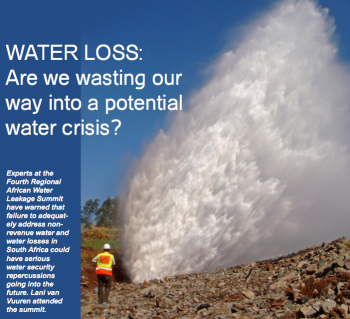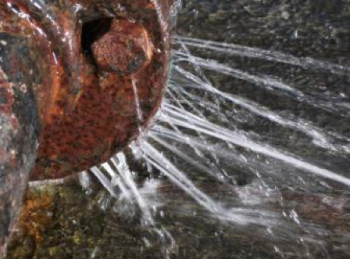WATER LOSS: Are we wasting our way into a potential water crisis?
The summit, held in Midrand, is the brain-child of Dr Ronnie McKenzie, MD of WRP Consulting Engineers, and follows on from the successful series of water demand management workshops and water demand management Master classes presented annually by WRP since 1997.
Endorsed by the International Water Association, with sponsorship from WRP, Rand Water and the Water Research Commission, the 2014 event was the most popular yet, attracting over 180 delegates from eight countries. The main aims of the summit were to create general awareness of the need to manage water losses throughout South Africa, and to highlight the status quote as far as water resources and progress in addressing losses each year.
That South Africa is not yet taking the importance of water loss control seriously enough ran as a key message through most of the presentations at the Summit. And the warning that this could have serious repercussions in areas where maximum water supply levels have been reached was too loud to ignore.
Keynote speaker, Prof Mike Muller, visiting Adjunct Professor at the Wits School of Governance and Commissioner in the National Planning Commission, confirmed the need to elevated water losses to a level where politicians would take interest. Water conservation and water demand management was a critical intervention required to keep South Africa water secure.
“Reducing growth in water demand is just as important as increasing its supply. Already, 30% of the bulk water-supply systems monitored by the Department of Water and Sanitation (DWS) require water resource security interventions.”
Current planning assumes it will be possible to achieve an average reduction in water demand of 15% below baseline levels in urban areas by 2030, Prof Muller continued. “Achieving demand reduc- tions on this scale will require programmes to reduce water leakage in distribution networks and improve efficient domestic and commercial water use.”
A CONTINUING CHALLENGE
It was during his 2010 State of the Nation address that President, Jacob Zuma, alerted South Africans to the country’s water scarcity and the need to bring water losses under control. The year 2014 was set as the target for municipalities for reducing water loss percentages by half.
While this target date has now come and gone, water loss control has shown no marked improvement. The latest figures from the DWS, presented at the Summit by Allestair Wensley, Chief Director: Water Services Macro Planning, indicate the seriousness of the water loss problem in South Africa. At present, around 37% of all water supplied to municipalities is lost.
While this compares well with the world average, it is far from ideal for a water-scarce country such as South Africa. Even more worrying is the fact that the latest figures were gathered from only 52% of 122 of South Africa’s municipalities.
While this represents about 75% of the total water supplied to municipalities, it is concerning that almost half of the country’s municipalities still do not adequately monitor their water losses. In the worst performing province, North West, only four municipalities could provide data.
“To manage their water resources sustainably, municipalities need to measure their water use in the form of a water balance, and to continually update this information and report against water conservation and water demand management targets,” Wensley explained. “While some municipalities, chiefly the metros, have comprehensive data on a large number of indicators, many municipalities have only very basic information or even no information.”
It is not only deteriorating water-supply infrastructure that is to blame, we are also wasting water within our homes. The DWS study indicates that average per capita use in South Africa has increased from 252 l/person/day in 2005 to 257 l/person/day.
Not surprisingly, the country’s metropolitan areas have the highest per capita water consumption, 274 l/person/day.
“Municipalities must encourage their consumers to appreciate the value of water and enforce the user pays principle,” noted Wensley. “They should also set cost reflective tariffs and increase payment levels by the encouragement of consumer leak fixing, prosecution of illegal water connections and the reduction of water theft.”
THREAT TO WATER SECURITY
For areas such as Gauteng, where continuing water security is already on a knife’s edge, reducing water losses has become an absolute necessity. Paul Herbst, Director: Water Use Efficiency at DWS reported on the importance of water conservation in the Vaal River system, which serves about 20 million people and generates around 60% of the national domestic product.
With the exception of Tshwane, municipalities in the province have been unable to achieve the water loss control targets set to maintain water security until Phase II of the Lesotho Highlands Water Project comes on stream in 2023. Due to bulk water constraints main water supply authority, Rand Water, has had its abstraction license capped at 1 600 million m3/a although it has already supplied 1 652 million m3/a in 2014.
To date, the province’s saving grace has been the above-average rainfall experienced in recent years. However, this could change should a below average year be experienced, and to date, rain in the province has been far from ideal.
Herbst illustrated how when a drought does occur, the reservoir storages in the Vaal River system can drop to restriction levels in less than three years. A previous drought saw the Vaal Dam’s water storage levels drop 70% in only two and a half years. While three years may seem a long time this is worrying considering droughts lasting longer than ten years are not unusual in South Africa.
He strongly advised municipalities to gear up their water conservation and water demand management activities before the next drought, which is now overdue, kicks in. This can be achieved with a four-pronged strategy comprising social interventions (such as education and awareness campaigns), economic interventions (such as municipal tariff structures), technical interventions (such as active leakage control and improved metering) and legislative interventions.
According to Dr McKenzie, South Africa experiences some of the highest water losses in some areas compared to other African countries. A major contributor to this fact is the legal requirement to provide free basic water.
“In other African countries where such water losses are experienced; they simply cut off the water and move to intermittent supply as is common in many developing countries.” However, this is not the ideal way of dealing with water losses, notes Dr McKenzie. “Intermittent supply is potentially very dangerous as it leads to spread of disease, particularly in poorer areas. Without a reliable water supply, diseases such as typhoid and cholera will become commonplace.”
Dr McKenzie comments that South Africa has an excellent water supply in most parts of the country, and that intermittent supply must be avoided at all costs – the maintenance costs will pale into insignifi- cance when compared to the costs that the country will face if it allows intermittent supply to become the norm rather than the exception. “You cannot provide hygienic conditions in densely populated urban areas without a reliable, permanent water supply, and you cannot provide a permanent water supply without proper maintenance.”
EYES AND SHOVELS ON THE GROUND
There is no quick solution to improved water loss control. You cannot find a buried or closed valve from an armchair, adds Dr McKenzie. “Water losses are increasing in many parts of the country and will continue to do so until municipalities start spending approximately 2% of the value of their water infrastructure annually on maintenance. Without such dedicated investment, the infrastruc- ture will continue to deteriorate and leakage will increase.”
The following are the basic water loss control measures that should be in place in a municipality:
-
All visible leaks should be repaired as soon as possible (within 24 hours);
-
All boundary valves should be identified and properly serviced. They must be checked monthly to prevent unauthorised opening and closing;
-
Communities should be educated on how to reduce water losses within households and assisted if necessary; and
-
Bulk management meters must be in place and used to derive a reliable water balance.
Municipalities should start seeing water losses as an opportunity, not only to improve their water security, but also to grow their economies. Water losses offer a great opportunity to municipalities to save water and create employment which can be cost-effective with a payback only a year in some cases. If money is a problem, municipalities should opt for measures that will provide a positive payback in the same financial year.
Unfortunately, water loss control has become a big business opportunity and many new high-tech solutions are being offered as the solution to all of the problems being experienced by municipalities. Only once the basic are sorted out should municipalities embark on the bells and whistles interventions, notes Dr McKenzie. “Water loss control requires feet on the ground and many hands donning picks and shovels – potentially the work needed can create many employment opportunities in every municipality.”
NOT ALL DOOM AND GLOOM
It was not all doom and gloom at the Fourth Regional African Water Leakage Summit. Delegates heard various presentations including examples where water demand management measures have been implemented with great success, including case studies from Johannesburg, Tshwane, Ekurhuleni, Emfuleni and others.
Many municipalities in South Africa are doing remarkably well considering the general lack of political support and resources that the water managers receive, says Dr McKenzie. Municipalities where water losses are being successfully addressed usually have a champion in the water department who is both dedicated and enthusiastic in addressing water losses.
Drakenstein, in the Western Cape, was held up as a prime success example where municipal engineer, André Kowaleski, and his colleagues have managed to reduce their non-revenue water from over 33% to less than 12% in less than 15 years (to read more about how the municipality achieved this, see ‘Drakenstein proves small municipalities can save water’ in the Water Wheel January/February 2014)
“All of the large metros have some top quality water loss personnel as do most of the large municipalities and water boards. These people must just be given the political support and resources needed to do their jobs and be allowed to get on with it. Before it’s too late.


